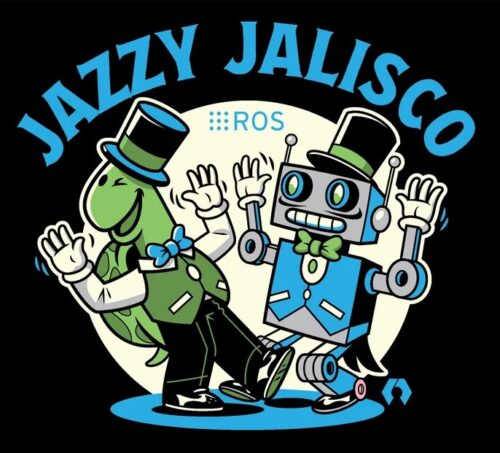|
Listen to this article |
The Open Source Robotics Foundation (OSRF) yesterday released ROS 2 Jazzy Jalisco. The 10th version of ROS 2 is a long-term support (LTS) release that will be supported until May 2029. Jazzy Jalisco offers a host of new features and enables connectivity between existing ROS code and the Intrinsic platform. Intrinsic, a spinout of the X moonshot division of Alphabet in mid-2021, acquired the Open Source Robotics Corporation in late 2022.
OSRF said ROS 2 Jazzy Jalisco is primarily supported on the following platforms:
- Tier 1 platforms: Ubuntu 24.04 (Noble): amd64 and arm64 | Windows 10 (Visual Studio 2019): amd64
- Tier 2 platforms: RHEL 9: amd64
- Tier 3 platforms: macOS: amd64 | Debian Bookworm: amd64
You can read about all the new features in the release notes and changelog, but OSFR highlighted the following features:

ROS Jazzy Jalisco was released on World Turtle Day.
Easier Gazebo integration: Starting with Jazzy, OSRF is trying to improve the usability of Gazebo with ROS while still giving users the option to use their favorite simulator. To do this, it started recommending a particular Gazebo release for each ROS release. For Jazzy Jalisco, the recommended Gazebo release is Gazebo Harmonic. From now on, for each recommended Gazebo release, OSRF will distribute Gazebo vendor packages that users can easily install so they can get started quickly.
ROS command line interface improvements: ROS 2 command line sports a handful of new features that should make life easier, OSRF said. Here are a couple of highlights:
- Pick your own log file names 1. Just add –log-file-name to set a custom log file for a ros2 run command.
- Set your own Quality of Service 6 when calculating topic statistics.
- Calls to ros2 service info now report the number of connected clients.
- Actions now report their type information – i.e. ros2 action type \action_name returns the action type.
ROSBag improvements: OSRF said ROS services play a critical role in any ROS system, as most developers use services as the building blocks for more complex behaviors or as the user-facing API for a robot. Making a robot perform a behavior is often as simple as calling a quick service request. On the other hand, ROSBags are often used by ROS developers much like an airplane’s “black box,” with ROSBag data often being used to analyze and debug failure modes.
Unfortunately, in all previous ROS 2 releases, ROSBag files could not log service calls, making it difficult to understand the series of service calls that led to a particular failure mode. Jazzy fixes this oversight by adding the ability to log and replay service calls directly to a ROSBag file.
RViz2 changes: RViz2, the built-in ROS 2 visualization tool, comes with a suite of new features that improve RViz’s overall usability and help filter out unnecessary information, OSRF said. Some of the new features include:
- Regex-based filters for TF 1 – you can now show and hide transforms based on their name.
- Topic frequency in status bar 4 – all topics now automatically report their frequency in Hz.
- Reset time via keyboard 5 – You can now reset your simulation time by pressing “R.”
- Visualize point_cloud_transport 5 – You can now subscribe to point_cloud_transport topics
- ROS 1 Feature Parity for DepthCloud, AccelStamped, TwistStamped, WrenchStamped and Effort message types.
OSRF also announced the name of the next ROS 2 release that will come out in May 2025. It will be called “Kilted Kaiju.”
At the start of 2024, OSRF also introduced a new version of the Open Robotics Middleware Framework (Open-RMF). This is a free, open-source, modular software system that enables interoperability between multiple fleets of robots and physical infrastructure. Introduced in 2021, Open-RMF is used in a variety of environments such as airports, hospitals, seaports, shopping malls, warehouses and more. Open-RMF won an RBR50 Robotics Innovation Award in 2021 for its efforts around robot interoperability.
ROS 2 Jazzy Jalisco works with Intrinsic
Intrinsic said the addition of support for the Zenoh protocol will now enable connectivity between existing ROS code and the Intrinsic platform. It added that this should enable robust communication between the platform and the tools that ROS developers are already familiar with.
Intrinsic first’s product, Flowstate, is built on the IntrinsicOS. Introduced in May 2023, Flowstate is a developer environment for robotics solutions, for visualizing processes, associated perception and motion planning. Flowstate is starting with support for industrial robots as this class of robotics operates in semi-structured settings, which simplifies many of the system variables. The product roadmap is to build a set of software skills that can be extended to other classes of robots.
Intrinsic earlier this month said it is using NVIDIA’s foundation models to improve robotic grasping. Enlisting NVIDIA Isaac Sim on the NVIDIA Omniverse platform, Intrinsic generated synthetic data for vacuum grasping using computer-aided design models of sheet metal and suction grippers. This allowed Intrinsic to create a prototype for its customer Trumpf Machine Tools, a leading maker of industrial machine tools.





